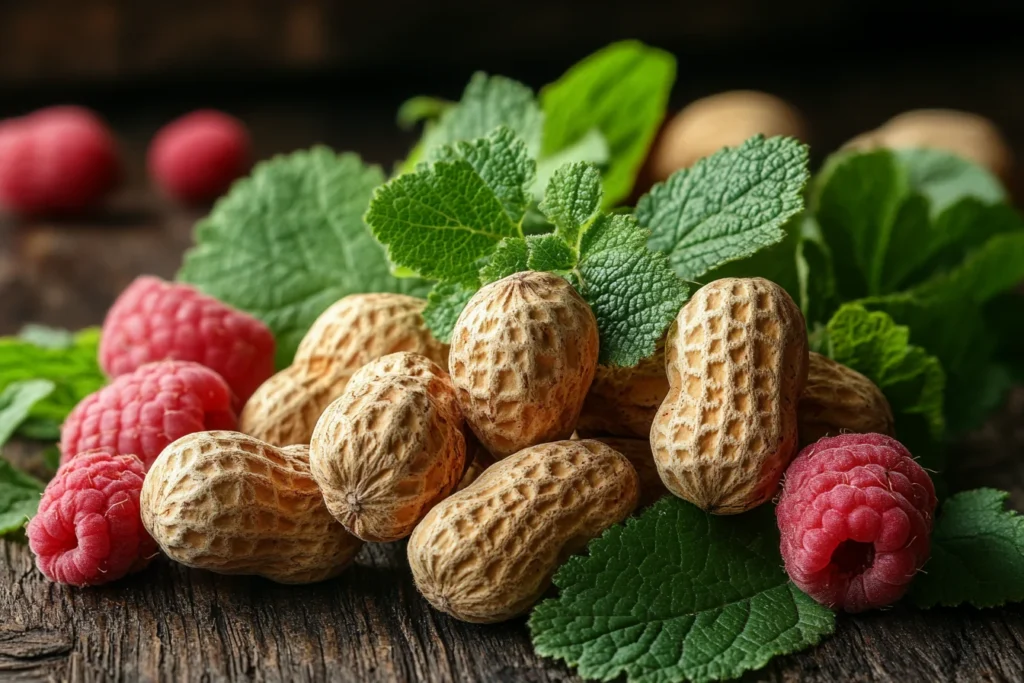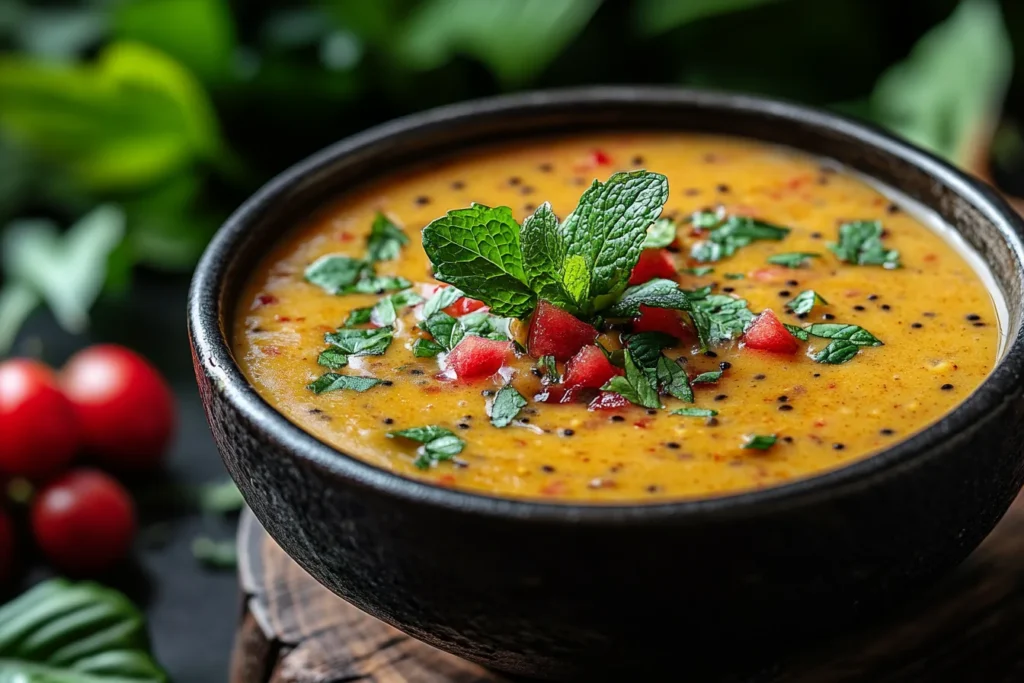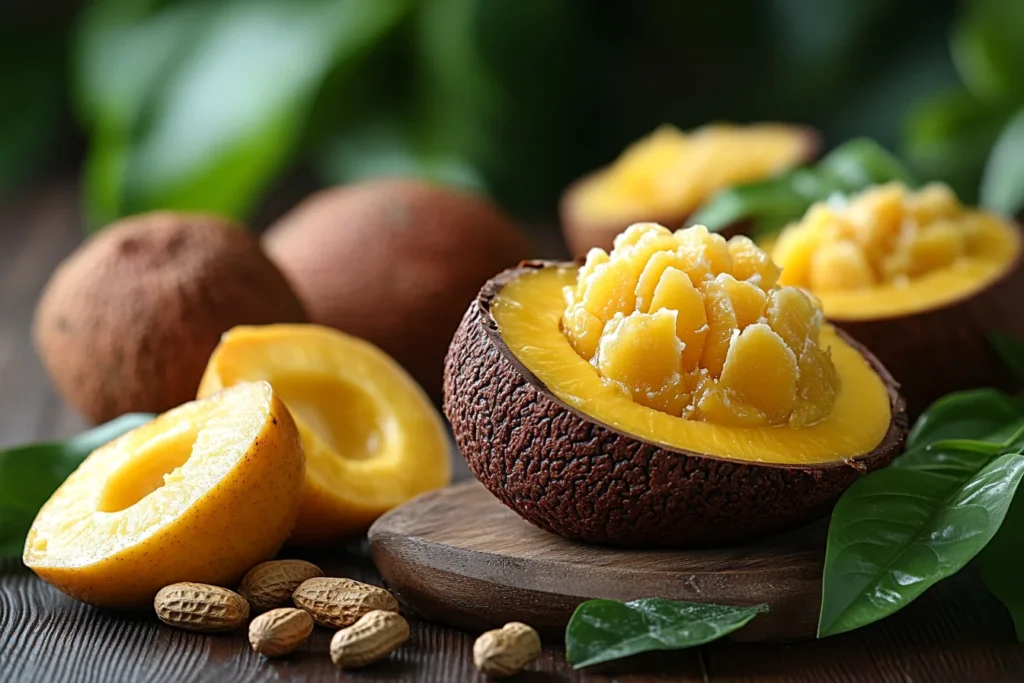What Is Peanut Butter Fruit?
Is peanut butter fruit good for health? This quirky, 100% natural tropical fruit might sound like something dreamed up in a lab, but it’s real and totally fascinating. Officially called Bunchosia glandulifera, this vibrant fruit grows on a shrub or small tree native to South America, particularly in Colombia and Venezuela. Its unique nickname comes from its surprising flavor and texture, which resemble you guessed it peanut butter! Whether you’re a foodie, plant lover, or someone curious about new flavors, this fruit is bound to pique your interest.
If you’re already thinking of ways to enjoy this fruit, you might like to check out our article on Fruit with Peanut Butter Recipes. It’s filled with tasty ideas for combining peanut butter’s creamy goodness with fruits like this.
Let’s dive into its appearance. Peanut butter fruit is small, about the size of a large grape or small plum. When fully ripe, it turns a striking red to orange color. Inside, you’ll find soft, creamy flesh surrounding a few seeds. Its texture is dense and custard-like, making it a close match to a spreadable snack. Honestly, if you’re curious about combining different fruits with spreads, you’ll want to explore Is Fruit with Peanut Butter Healthy? for some helpful tips and ideas!
But the real magic is in the taste. The flavor of peanut butter fruit is mild, sweet, and nutty, with hints of—you guessed it—peanut butter. It’s not an exact replica of the jarred stuff you’d find in your pantry, but the nutty undertones and creamy mouthfeel make it an unmistakable cousin. It’s almost like nature’s version of peanut butter, minus the added sugar, salt, and oil.
This fruit isn’t just delicious; it’s also packed with nutrients. It’s rich in vitamins A and C, making it a great addition to your diet if you’re looking for a natural immune boost or a little extra glow for your skin. Plus, the fruit’s fiber content can help support digestion, so it’s as functional as it is flavorful.
While peanut butter fruit isn’t something you’ll commonly find at your local grocery store, it’s gaining popularity among gardeners and tropical fruit enthusiasts in warmer climates. It grows well in subtropical and tropical areas, and some adventurous home growers are planting it right in their backyards.
In short, peanut butter fruit is a delightful little gem of the tropics. Whether you’re a curious eater or a passionate gardener, this unique fruit offers a fun way to shake up your routine and maybe even surprise your taste buds.

Table of Contents
Health Benefits of Peanut Butter Fruit
Peanut butter fruit may not be a family call, however its health advantages are mind-blowing for one of these small tropical treat. This nutrient-packed fruit doesn’t just offer a completely unique taste—it additionally grants a number vitamins, minerals, and antioxidants that support normal wellbeing. Whether you’re consuming it clean or turning it into jams, smoothies, or spreads, this fruit merits a niche in your radar for its nutritional perks.
Let’s start with its vitamin content. Peanut butter fruit is rich in vitamin A, which is essential for maintaining healthy vision, immune function, and skin. This makes it a great natural choice for anyone looking to protect their eyes and promote a clear, glowing complexion. It’s also a good source of vitamin C, a powerful antioxidant that helps strengthen the immune system and supports collagen production for youthful skin. Together, these vitamins make the fruit a beauty and immunity booster.
Next up, fiber. Like many fruits, peanut butter fruit contains a healthy dose of dietary fiber. Fiber is a must for maintaining good digestive health—it keeps things moving smoothly and helps prevent constipation. Fiber also contributes to a feeling of fullness, which can support weight management and reduce unnecessary snacking.
Peanut butter fruit also contains antioxidants, which help fight free radicals in the body. Free radicals are unstable molecules that can damage cells over time, leading to premature aging and increased risk of chronic diseases. Antioxidants help neutralize these molecules, making the fruit a smart addition for anyone focused on long-term health.
Beyond these staples, the fruit contains natural sugars and healthy carbohydrates that provide a quick, clean source of energy. If you’re looking for a snack that won’t weigh you down, peanut butter fruit is a great option. Its sweet, nutty flavor makes it satisfying without the need for added sugar.
For those in warmer climates or with access to the fruit, peanut butter fruit is also valued for its low-fat content and natural anti-inflammatory properties. This can be particularly beneficial for individuals managing conditions like arthritis or general inflammation.
Potential Risks and Considerations of Peanut Butter Fruit
While peanut butter fruit is a nutritious and delicious tropical treat, it’s important to be mindful of potential risks and considerations before diving in. Like any food, individual reactions can vary, and understanding its effects can help you enjoy it safely and responsibly.
Allergic Reactions
Though rare, some individuals may experience allergic reactions to peanut butter fruit. If you have a history of food allergies, especially to tropical fruits or nuts, it’s wise to proceed with caution. Symptoms like itching, swelling, or gastrointestinal discomfort may signal an allergic response. Trying a small amount initially is a good way to check for any adverse effects.
Seed Safety
Peanut butter fruit contains small seeds that are generally not consumed. While the flesh is perfectly safe and nutritious, swallowing the seeds accidentally might cause minor discomfort. Additionally, the seeds of some tropical fruits can contain naturally occurring compounds that are not safe to consume in large quantities. It’s best to stick to eating the soft, creamy flesh and discard the seeds.
Digestive Sensitivity
Like many fiber-rich fruits, peanut butter fruit can cause mild digestive upset if eaten in large amounts, especially for those with sensitive stomachs. Overeating can lead to bloating or gas due to its fiber content. Moderation is key to enjoying its benefits without experiencing discomfort.
Ripeness Matters
Unripe peanut butter fruit may not only taste unpleasant but could also cause mild stomach upset. The fruit should be fully ripe—usually indicated by its deep orange-red color and soft texture—before consuming. If it’s underripe, the flavor can be overly tart, and the texture may not be as enjoyable.
Limited Availability and Quality
Because peanut butter fruit isn’t widely cultivated or to be had in mainstream markets, sourcing it can sometimes be problematic. If you’re buying it on-line or through area of expertise suppliers, ensure the source is respectable to keep away from spoilage or infection. For home growers, proper care and harvesting practices are critical to provide secure, awesome fruit.
Interaction with Preexisting Conditions
If you’re managing situations like diabetes, keep in thoughts that peanut butter fruit contains herbal sugars. While it’s a more fit opportunity to processed chocolates, tracking component sizes remains vital to avoid spikes in blood sugar degrees.
Environmental and Ethical Considerations
Lastly, like many tropical end result, peanut butter fruit can also come from regions with constrained environmental oversight. Supporting ethical growers and sustainable farming practices is a accountable manner to revel in this unique fruit whilst protective its local habitats.

How to Include Peanut Butter Fruit in Your Diet
Peanut butter fruit isn’t just fun to say—it’s surprisingly versatile in the kitchen! Its creamy texture and nutty sweetness make it a unique addition to all sorts of meals and snacks. If you’ve got your hands on this tropical gem and aren’t sure what to do with it, here are some simple and delicious ways to work it into your diet.
- Enjoy It Fresh
The easiest way to eat peanut butter fruit is straight off the tree (once it’s ripe, of course). Simply wash the fruit, cut it open, and scoop out the soft, creamy flesh. Its natural sweetness makes it a great snack on its own, especially if you’re craving something light and satisfying. - Blend It Into Smoothies
Peanut butter fruit is perfect for smoothies! Its creamy consistency blends beautifully with other fruits like bananas, mangoes, or strawberries. Toss in a handful of spinach or kale for added nutrients, and you’ve got a balanced, flavorful drink. For a tropical vibe, add coconut water or almond milk as your base. - Spread It on Toast
If you love peanut butter on toast, this fruit can take things to the next level. Mash the flesh into a spreadable paste and layer it on whole-grain bread. Top it with sliced bananas, a drizzle of honey, or a sprinkle of cinnamon for a breakfast that’s both tasty and nutritious. - Make a Jam or Spread
With its natural sweetness, peanut butter fruit is an ideal candidate for homemade jam. Simmer the pulp with a little water, sugar, and lemon juice, then blend it until smooth. Store it in the fridge and use it as a spread for bread, crackers, or pancakes. - Add It to Desserts
Peanut butter fruit’s nutty flavor pairs beautifully with sweet treats. Use it as a topping for ice cream, yogurt, or pudding. You can also mix it into batter for muffins, cakes, or cookies for a tropical twist. - Pair It with Savory Dishes
For a creative twist, try using peanut butter fruit as a base for sauces or dressings. Mix the pulp with lime juice, a touch of chili, and some olive oil to create a zesty dressing for salads or grilled vegetables. Its nutty undertones also pair well with roasted chicken or tofu. - Freeze It for a Cool Treat
Scoop out the flesh, freeze it in ice cube trays, and use the frozen chunks as a refreshing snack or to cool down drinks. You can also blend the frozen fruit with a splash of milk to make a quick, healthy sorbet. - Experiment with Baking
Incorporate mashed peanut butter fruit into baked goods for a boost of flavor and moisture. It works well in quick breads (think banana bread), muffins, and even pancakes.
Pro Tips for Using Peanut Butter Fruit
Ripeness is Key: Always use fully ripe fruit for the best flavor and texture.
Storage: If you can’t eat the fruit right away, store it in the refrigerator to keep it fresh for a few days.
Combine with Complementary Flavors: Peanut butter fruit pairs well with tropical fruits, nuts, honey, and even chocolate for added richness.
FAQs About Peanut Butter Fruit and Health
Is peanut butter fruit healthful?
Yes, it’s packed with nutrients like nutrients A and C, fiber, and antioxidants. These assist immune fitness, digestion, and pores and skin well-being, making it a nutritious addition in your weight loss program.
Can I eat peanut butter fruit every day?
You can enjoy it regularly, but moderation is key due to its natural sugars. Eating a small amount daily is safe for most people, provided you’re not allergic.
Does peanut butter fruit taste like peanut butter?
Not exactly, but it has a mild, nutty flavor and creamy texture that’s similar. It’s sweeter and fruitier than traditional peanut butter.
Are there any risks to eating peanut butter fruit?
The flesh is safe, but avoid eating the seeds. Some people may experience mild digestive upset or allergies, so try a small portion first.

Conclusion
Peanut butter fruit is a lovely tropical treasure that combines precise taste, creamy texture, and surprising health blessings. Whether you’re playing its sweet, nutty taste sparkling, blending it into smoothies, or experimenting with recipes, this fruit offers a a laugh and nutritious manner to shake up your food regimen.
While it’s now not broadly available, its growing recognition approach it’s really worth searching out or even planting in appropriate climates. Just hold a watch on portion sizes, make certain it’s absolutely ripe earlier than ingesting, and take note of any capability allergic reactions.
Incorporating peanut butter fruit into your food isn’t simply delicious—it’s a step closer to exploring the superb variety nature has to provide. So, in case you get the danger to strive it, dig in and experience each creamy, nutrient-packed chunk!

